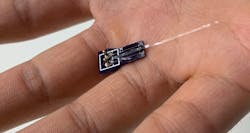Parylene photonics enable future waveguide-based optical biointerfaces
Optical systems for biomedical applications, such as miniaturized and flexible optical tools for ambulatory and on-demand imaging and manipulation of biological events in the body are badly needed. However, integrated photonic technology has up to now mainly evolved around developing devices for optical communications. The advent of silicon photonics was a turning point in bringing optical functionalities to the small form-factor of a chip. However, silicon is a dangerously rigid material for interacting with soft tissue in biomedical applications.
In response to this need for flexibility, Maysam Chamanzar of Carnegie Mellon University (Pittsburgh, PA) has developed an optical platform tailored to biointerfaces with both optical capability and flexibility.1 His solution, Parylene photonics, is the first biocompatible and fully flexible integrated photonic platform ever made.
Chamanzar’s lab designed ultracompact optical waveguides by fabricating silicone (PDMS), an organic polymer with a low refractive index, around a core of Parylene C, a polymer with a much higher refractive index. The contrast in refractive index allows the waveguide to pipe light effectively, while the materials themselves remain extremely pliant. The result is a platform that is flexible, can operate over a broad spectrum of light, and is just 10 μm thick.
The design was created with neural stimulation in mind, allowing for targeted stimulation and monitoring of specific neurons within the brain. Crucial to this is the creation of 45° embedded micromirrors. While prior optical biointerfaces have stimulated a large swath of the brain tissue beyond what could be measured, these micromirrors create a tight overlap between the volume being stimulated and the volume recorded. These micromirrors also enable integration of external light sources with the Parylene waveguides.
Half a millimeter bending radius
“The high index contrast between Parylene C and PDMS enables a low bend loss,” says Jay Reddy, one of the researchers. “These devices retain 90% efficiency as they are tightly bent down to a radius of almost half a millimeter, conforming tightly to anatomical features such as the cochlea and nerve bundles.”
Applications for Parylene photonics range far beyond optical neural stimulation, and could one day replace current technologies in many areas of optical biointerfaces. These flexible optical devices can be inserted into the tissue for short-term imaging or manipulation or can be used as permanent implantable devices for long-term monitoring and therapeutic interventions.
Additionally, Chamanzar and his team are considering possible uses in wearables. Parylene photonic devices placed on the skin could be used to conform to difficult areas of the body and measure pulse rate, oxygen saturation, blood flow, cancer biomarkers, and other biometrics. As further options for optical therapeutics are explored, such as laser treatment for cancer cells, applications for a more versatile optical biointerface will continue to grow.
Source: https://engineering.cmu.edu/news-events/news/2020/09/21-parylene-photonics.html
REFERENCE:
1. Jay W. Reddy, Maya Lassiter, and Maysamreza Chamanzar, Nature Microsystems & Nanoengineering (2020); https://doi.org/10.1038/s41378-020-00186-2.
About the Author
John Wallace
Senior Technical Editor (1998-2022)
John Wallace was with Laser Focus World for nearly 25 years, retiring in late June 2022. He obtained a bachelor's degree in mechanical engineering and physics at Rutgers University and a master's in optical engineering at the University of Rochester. Before becoming an editor, John worked as an engineer at RCA, Exxon, Eastman Kodak, and GCA Corporation.

